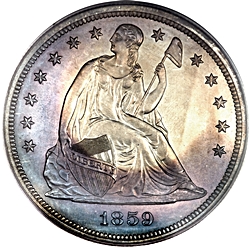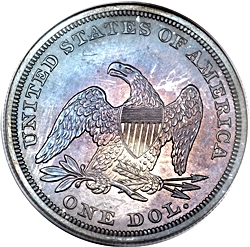 |
1859
 

|
 |
General Comments
|
| |||||||||||||||||||||
1859 Die Marriages
6 die marriages have been positively identified. The following table summarizes the known die marriages for 1859:
Click the links below to view the details of the die marriages.
Die Marriage |
Rarity |
Obverse Die |
Reverse Die |
Estimated Survivors |
| OC-1 | R4+ | 1 | A | 110 |
| OC-2 | R3 | 1 | B | 370 |
| OC-3 | R3 | 2 | C | 345 |
| OC-4 | R4- | 3 | D | 175 |
| OC-P1 | R3+ | P1 | 1859 PA | 345 |
| OC-P2 | R7+ | P1 | 1856 PA | 5 |
Three obverse dies were paired with 4 reverse dies to strike all business strikes. All the business strike die marriages are scarce, but none particularly rare. None of the business strike dies were used for proofs.
Two different proof die marriages have been confirmed. Both use Obverse P1, which shows minor repunching on the 1. The original digit was punched slightly low, then corrected to the proper position. The first proof die marriage, our OC-P1, is the one most commonly seen. It uses a reverse die which was also used for 1851, 1852, 1854, and 1858 proofs. We believe that all these early dates are restrikes, minted after the 1859 proofs. The second proof die marriage, our OC-P2, uses a die, Reverse 1856 PA, that was first used for 1856 regular issue proofs. This die marriage is extremely rare. We’ve confirmed only a single example, an NGC PR64. It was auctioned by Heritage with the Jules Reiver collection in January, 2006. The photo in the Heritage archives doesn’t have enough resolution to confirm that attribution with absolute certainty, but when added to other circumstantial evidence we concluded that it was enough to merit adding the die marriage to our document. If anyone reading this currently owns the Reiver coin, or another example of this die marriage, we’d love to hear from you and have the opportunity to examine the coin.
1859 Business Strike Emission Sequence
Because no dies were shared between three of the four die marriages the emission sequence listed
below is partially arbitrary. We know that OC-1 came before OC-2, but we can’t say for sure where the other two
marriages fit in. If new marriages are discovered which share any of the known dies we’ll update the emission
sequence as required.
Emission Order |
Die Marriage |
Comments |
| 1 | OC-1 | Perfect obverse for all examples seen. |
| 2 | OC-2 | Obverse 1 die polish and the appearance of rim cuds indicate that OC-2 follows OC-1. |
| 3 | OC-3 | Placement in the emission sequence is arbitrary. |
| 4 | OC-4 | Placement in the emission sequence is arbitrary. |
1859 Proof Emission Sequence
With only a single example of the OC-P2 die marriage known the emission sequence is merely an educated
guess. If we have the opportunity to examine the Reiver coin, or another example of OC-P2, we’ll update this sequence
as required.
Emission Order |
Die Marriage |
Comments |
| 1 | OC-P1 | |
| 2 | OC-P2 |
1859 Quick Finder Chart
Attribution of 1859 die marriages is relatively easy. The obverse dies display few markers, but fortunately the date
positions are significantly different. The following table lists the keys for identifying each die marriage. Take
care in attributing Obverse 2 vs. the proof obverse. There are quite a few circulated proofs in business strike
holders. The Obverse 2 date is much higher in the field.
Die Marriage |
Obv Die |
Rev Die |
Right |
Keys |
| OC-1 | 1 | A | JR of C | Obverse: Slightly low date. Reverse: Horizontal shield line #1 extends to the left across the first shield border but not across the second. |
| OC-2 | 1 | B | JR of C | Obverse: Slightly low date. Reverse: Horizontal shield line #1 extends to the left outside the shield border but isn't seen between the borders. |
| OC-3 | 2 | C | LE | Obverse: High date. Reverse: Lightly doubled extension of horizontal shield line #1 into the wing feathers. |
| OC-4 | 3 | D | R QTR | Obverse: Left date, grid = 4-1.0. Reverse: NO extension of horizontal shield line #1 to the left. |
| OC-P1 | P1 | 1859 PA | LE | Obverse: Repunched 1, Grid=4-5.0. Date much lower than Obverse 2. Reverse: Lumps in the feathers of the lower left wing. |
| OC-P2 | P1 | 1856 PA | LE | Obverse: Repunched 1, Grid=4-5.0. Date much lower than Obverse 2. Reverse: Die rust lumps on the L in DOL and the first S in STATES. |
| Photo credits:
Obverse and reverse full photos: PCGS PR67 Cameo CAC, finest known, from the Heritage archives. |
